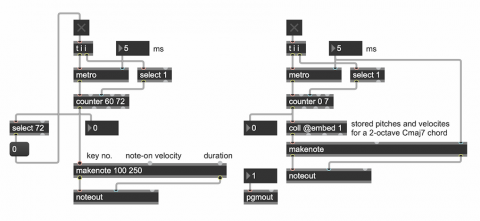Playing a pattern

These patches use timed counting—in both cases using a metro object and a counter—to step through a series of MIDI notes.
The example on the left sets the counter to count from 60 to 72, incrementing the count each time a bang is received from the metro. The numbers coming out of the counter are used directly as pitch values, to play a chromatic scale from middle C up to the C an octave above that. A select object is used to detect when the count has arrived at 72, and that triggers a message of 0 to the toggle to turn off the metro.
The example on the right uses the numbers 0 to 7 from a counter to look up pitch and velocity values that are stored in a coll (collection) object. Double-click the coll object to see its contents. Each line of the coll begins with an 'index' number (followed by a comma) that will be used to look up a message, then the message that will be sent out, then a semicolon to end the line. When an index number is received in the inlet of coll, the associated message will be sent out. Because the messages go to a makenote object, the numbers will be interpreted as the pitch and velocity values of a constructed MIDI note-on message. The messages in the coll form a pattern, playing a two-octave arpeggiation of a Cmaj7 chord, with diminishing velocities (i.e. a diminuendo). Because there is no automated stopping condition, the counter will proceed incessantly in a loop from 0 to 7 until the metro is stopped.